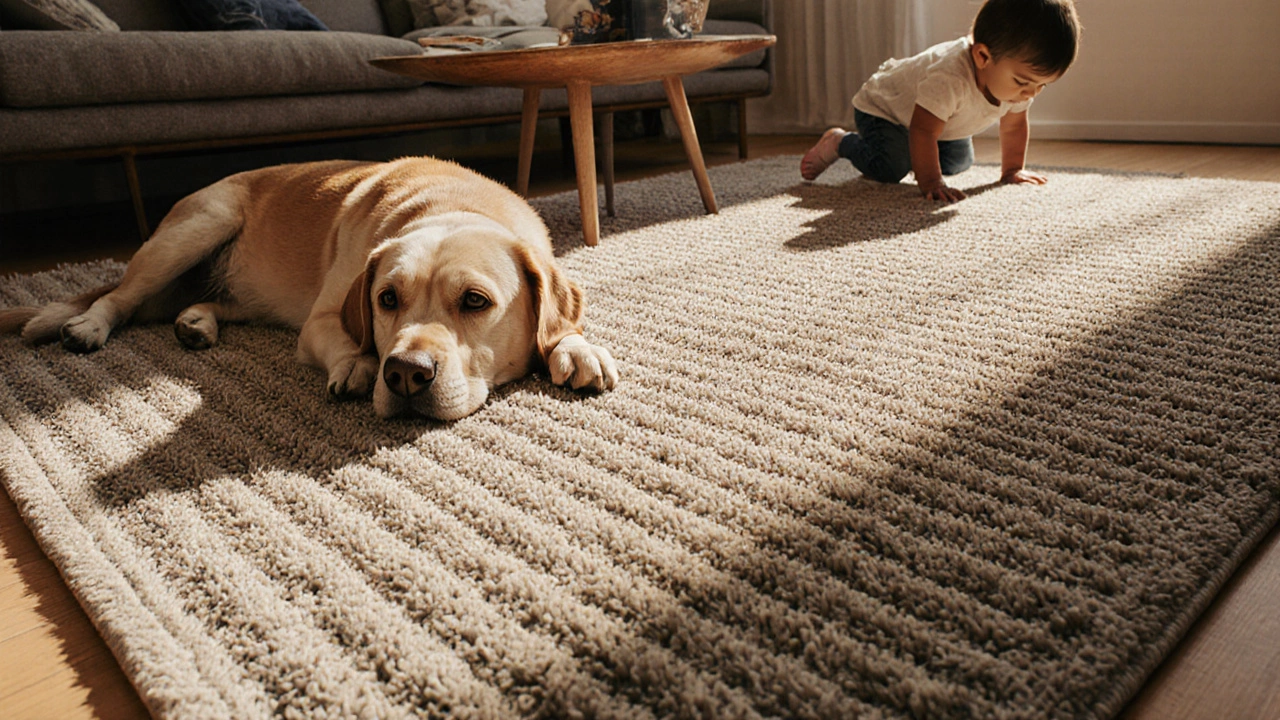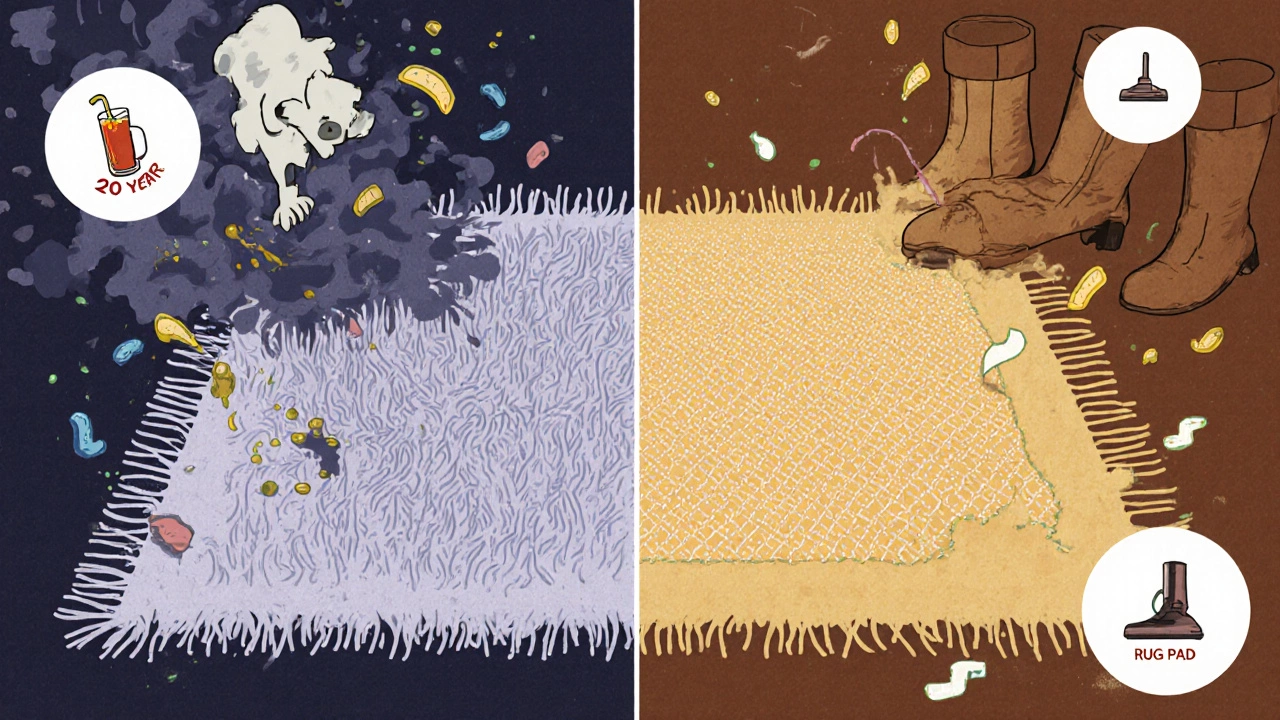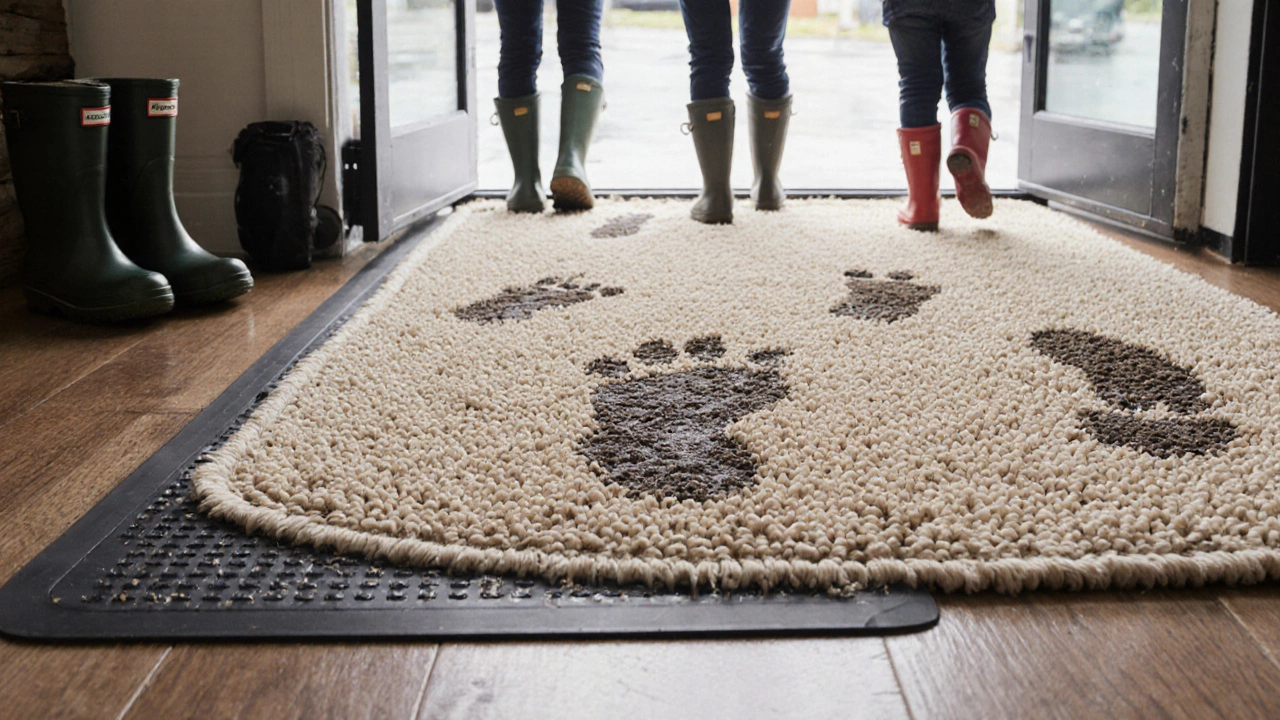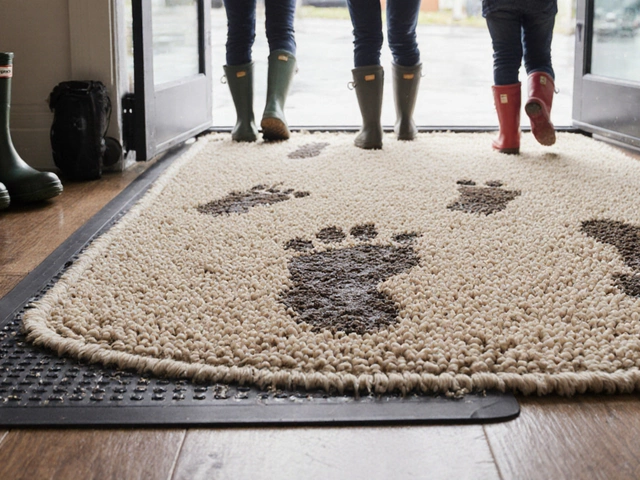If you’ve ever bought a rug that looked perfect in the store but started fraying, shedding, or flattening out in just a few months, you know the frustration. You’re not alone. Most people pick rugs based on color or pattern-then regret it when the traffic, pets, or kids start to take their toll. The truth? Not all rugs are built the same. Some are designed to last decades. Others? They’re decorative throwaways. So what type of rug actually holds up the best? Let’s cut through the marketing and look at what works in real homes-not just showrooms.
Not All Fibers Are Created Equal
The material of your rug is the single biggest factor in how long it lasts. There are four main types of rug fibers used in homes today: wool, nylon, polypropylene (olefin), and polyester. Each has different strengths and weaknesses.
Wool is the gold standard for durability. It’s naturally resilient, meaning it springs back after being crushed by foot traffic. Wool fibers can bend over 20,000 times before breaking-compared to synthetic fibers that often fail after 5,000. It also repels dirt and resists static, which is why high-end hotels and historic homes still use it. A well-made wool rug in a moderate-traffic area can easily last 20-30 years. But it’s not cheap, and it can fade in direct sunlight.
Nylon is the best synthetic option. It’s tough, stain-resistant (especially if treated), and holds its shape better than most alternatives. Nylon is what you’ll find in commercial spaces like hotels, schools, and offices because it handles heavy foot traffic without flattening. Brands like Mohawk and Shaw use high-twist nylon in their premium lines, and these rugs often come with 15-25 year warranties. It’s also the top choice for homes with pets-dogs’ claws don’t snag it the way they do with softer fibers.
Polypropylene (olefin) is the budget-friendly choice. It’s moisture-resistant, so it’s great for basements or outdoor spaces. But here’s the catch: it flattens fast under heavy use. If you’re putting it in a living room or hallway, expect it to look worn out in 3-5 years. It’s fine for low-traffic areas or seasonal use, but don’t count on it to survive daily chaos.
Polyester looks nice and is easy to clean, but it lacks resilience. It mats down quickly under foot traffic and doesn’t bounce back. You’ll see it in discount stores and online marketplaces. It’s pretty, but not built to last.
Construction Matters More Than You Think
Even the best fiber can fail if the rug is poorly made. Two things to check: pile height and construction method.
Pile height refers to how tall the fibers are. Low-pile rugs (under 0.5 inches) are more durable because there’s less fiber to crush and trap dirt. Think flatweaves, kilims, or tightly woven Berber styles. High-pile rugs like shag or plush are soft and cozy, but they show footprints, trap pet hair, and compress over time. If you have kids or pets, avoid anything taller than 0.75 inches.
Construction is equally important. Hand-knotted rugs are the most durable-they’re made by tying individual knots, one by one. These can last generations. Hand-tufted rugs are also good, but the backing glue can break down over time. Machine-made rugs are more affordable and consistent. Look for a high knot count (over 200 knots per square inch for wool, over 1,000,000 for nylon) and a tightly woven backing. Avoid rugs with loose threads or uneven edges.
Real-World Durability: What Works in Homes Like Yours
Let’s talk about actual use cases. What rug survives a household with two dogs, a toddler, and a front door that’s open all day?
In Auckland, where rain and muddy shoes are a daily reality, a durable rug needs to handle moisture, dirt, and constant traffic. The top performers we’ve seen in local homes:
- Wool Berber - Tight loops, low pile, natural stain resistance. A family in Ponsonby had one for 12 years with zero noticeable wear.
- Nylon twist pile - Used in a family home in Mount Albert with three kids and a Labrador. Still looks new after 8 years.
- Flatweave wool kilim - Popular in smaller apartments. Easy to vacuum, doesn’t trap allergens, and lasts over a decade.
On the flip side, the rugs that failed:
- A polyester shag from a big-box store-flattened in 9 months.
- A polypropylene outdoor rug brought inside-matted and faded after 18 months.
- A cheap, high-pile synthetic rug from an online flash sale-shedding fibers everywhere and smelled musty within a year.

What to Avoid: The Rug Myths That Cost You Money
There are a few myths that lead people to make bad choices.
Myth 1: “More expensive means more durable.” Not always. A $500 wool rug from a reputable brand will outlast a $1,200 poorly made one. Price isn’t the indicator-construction and fiber are.
Myth 2: “Synthetics can’t match wool.” Modern nylon can outperform wool in high-traffic areas. It’s more resistant to stains, doesn’t fade in sunlight, and is easier to clean. If you have kids or pets, nylon is often the smarter pick.
Myth 3: “Rug pads are just for cushioning.” Wrong. A good rug pad prevents slipping, reduces wear on the rug’s backing, and even extends its life by absorbing impact. Skip the cheap foam pad-go for felt or rubber-backed options designed for durability.
How to Test a Rug Before You Buy
You don’t need to be an expert to spot a durable rug. Here’s how to check in-store or online:
- Look at the back. A well-made rug has a tight, even backing. If you can see the weave clearly and the backing looks flimsy or glued on unevenly, walk away.
- Pinch the pile. If you can easily pinch and pull fibers apart, it’s low quality. Good rugs resist this.
- Check the label. It should list the fiber content (e.g., “100% wool,” “100% nylon”). Avoid vague terms like “premium synthetic.”
- Ask about warranty. Reputable brands offer 10+ year warranties on high-traffic rugs. If they don’t, they don’t stand behind it.
- Smell it. Cheap rugs often have a chemical odor. That’s off-gassing from adhesives or dyes-bad for indoor air quality and a sign of low-grade materials.

Best Rug for High-Traffic Zones: Quick Reference
| Area | Best Fiber | Pile Height | Why It Works |
|---|---|---|---|
| Entryway | Nylon or wool | Low (0.25-0.5 in) | Handles dirt, moisture, and heavy foot traffic without flattening. |
| Living Room | Wool or nylon | Low to medium (0.3-0.7 in) | Resists crushing from furniture and daily use. |
| Kitchen | Nylon or polypropylene | Low (0.25-0.5 in) | Moisture-resistant and easy to wipe clean. |
| Bedroom | Wool or polyester | Medium to high (0.5-1 in) | Comfort matters more than durability here. |
| Home with Pets/Kids | Nylon | Low (0.25-0.5 in) | Stain-resistant, doesn’t shed, claws don’t snag. |
How to Make Your Rug Last Longer
Even the best rug won’t last forever without care. Here’s what actually works:
- Rotate it every 6 months. This evens out wear, especially under furniture or in high-traffic paths.
- Vacuum weekly. Use a beater bar on low suction. Avoid vacuums with rotating brushes on delicate wool rugs.
- Spot clean spills immediately. Blot, don’t rub. Use cold water and mild detergent. Never soak.
- Use a rug pad. Felt or rubber-backed pads reduce friction and protect the rug’s backing.
- Keep direct sunlight off it. UV rays fade colors and weaken fibers over time. Use blinds or curtains.
With proper care, a high-quality nylon or wool rug can easily outlast your sofa, your kitchen cabinets, even your car. That’s the kind of value you’re really buying.
What is the most durable rug material for pets?
Nylon is the most durable rug material for pets. It resists claws, doesn’t shed fibers, and repels stains better than wool or polyester. Look for a low-pile, twist-pile nylon rug-these are easy to vacuum and clean after muddy paws or accidents. Brands like Mohawk’s SmartStrand or Shaw’s R2X are designed specifically for pet owners.
Can wool rugs handle high traffic?
Yes, wool rugs handle high traffic exceptionally well. Wool fibers are naturally springy and can recover from being compressed. They’re also stain-resistant and don’t attract static, which means less dirt buildup. A tightly woven wool Berber or flatweave in a low pile is ideal for hallways, entryways, or living rooms. Just avoid high-pile wool shags in busy areas-they’ll flatten faster.
Is a synthetic rug better than wool for durability?
For durability in high-traffic or messy homes, synthetic rugs-especially nylon-are often better than wool. Nylon doesn’t fade in sunlight, resists stains better, and is easier to clean. Wool is more luxurious and eco-friendly, but it can stain if not treated and may fade over time. If you have kids, pets, or a busy entryway, nylon wins. For quiet bedrooms or formal spaces, wool’s comfort and natural beauty make it worth the investment.
How long should a good rug last?
A high-quality wool or nylon rug, with proper care, should last 15-25 years. Lower-end synthetics like polyester or polypropylene typically last 3-7 years before showing major wear. The key isn’t just the material-it’s the construction. Rugs with a tight weave, low pile, and strong backing will outlast flimsier options by decades.
Should I buy a rug online or in-store?
Buy in-store if you can. You need to feel the pile, check the backing, and smell for chemical odors. If buying online, choose retailers with free returns and detailed product specs. Look for keywords like “low pile,” “nylon twist,” or “100% wool,” and avoid vague terms like “premium” or “luxury.” Check reviews that mention long-term use-especially from pet owners or families.
Final Tip: Buy Once, Buy Right
The cheapest rug isn’t the cheapest in the long run. A $200 rug that lasts 3 years costs more per year than a $600 rug that lasts 20. Think of it like buying shoes-you wouldn’t buy flimsy sneakers for daily hiking. Your rug is the foundation of your room. Invest in one that can handle your life. Pick nylon for heavy use, wool for timeless elegance, and always check the construction. The right rug won’t just look good-it’ll outlive trends, kids, and even your next move.

